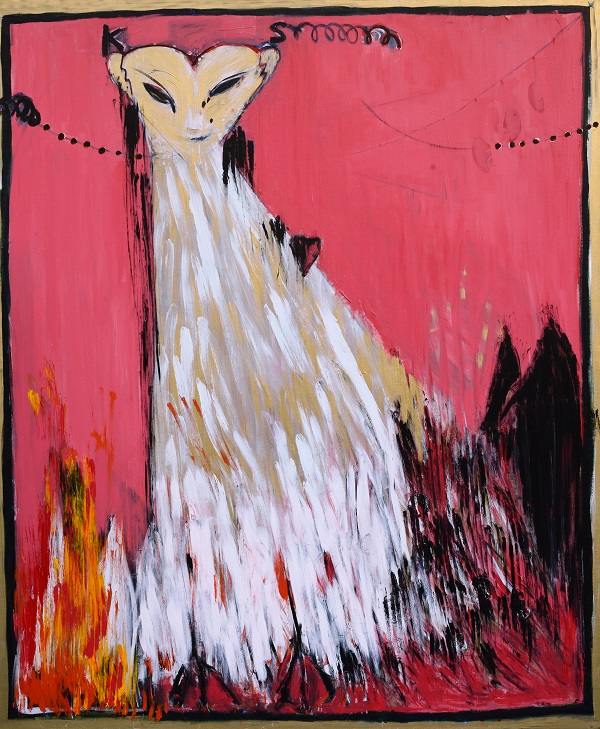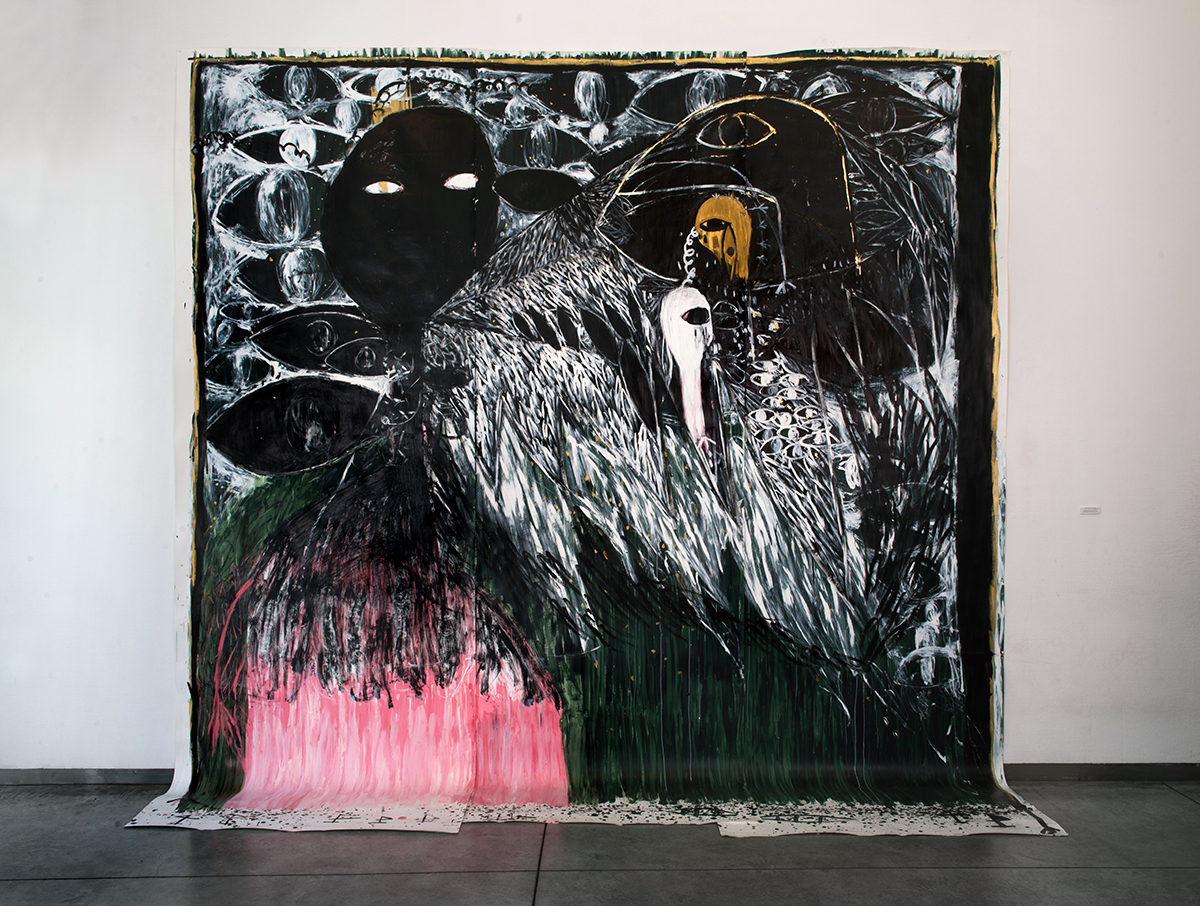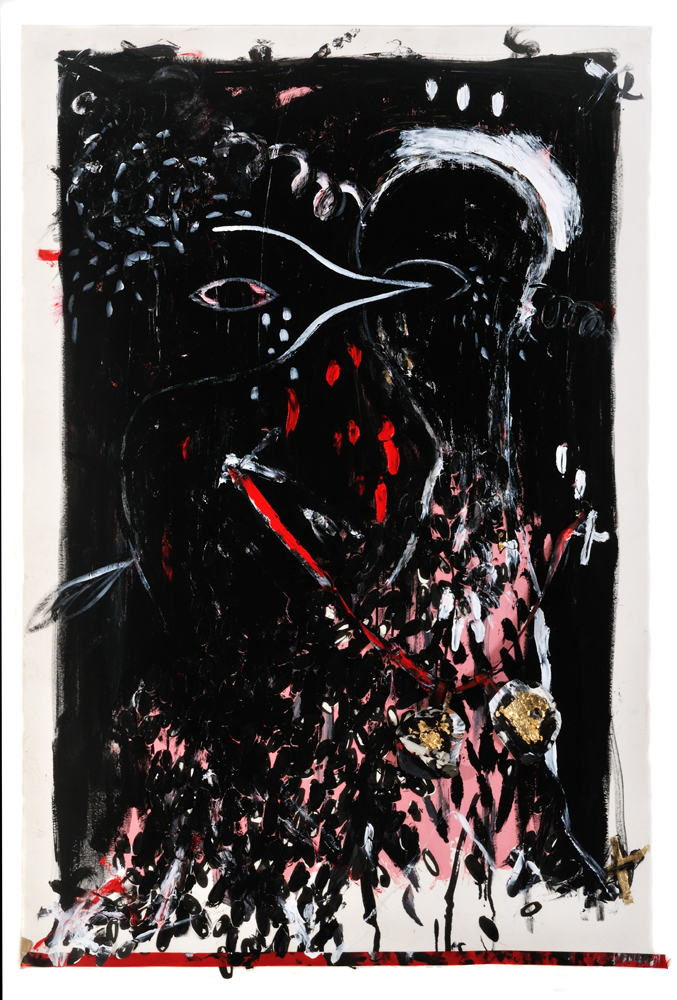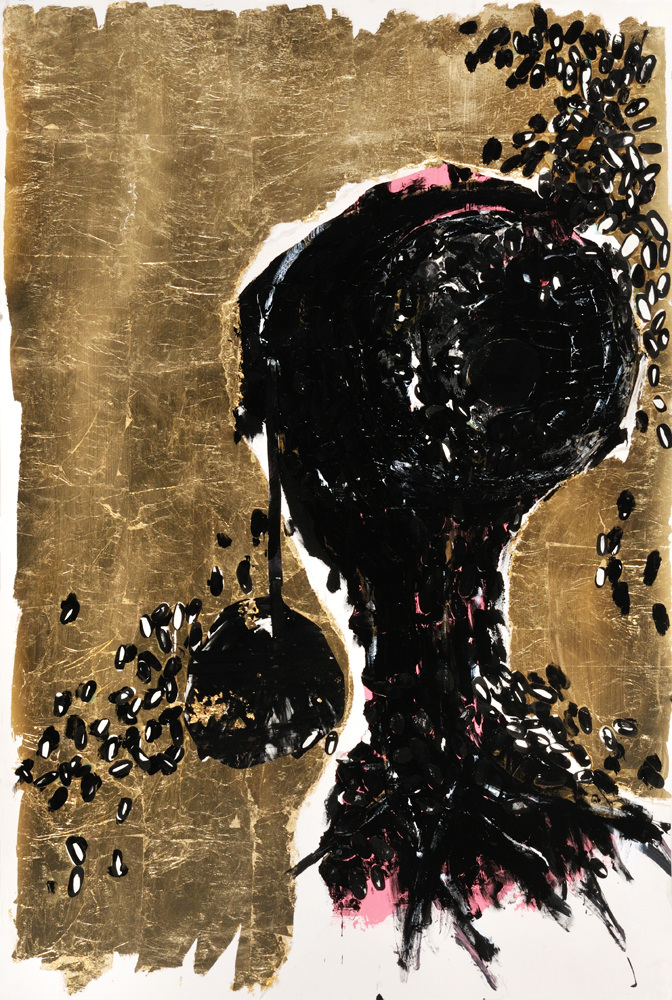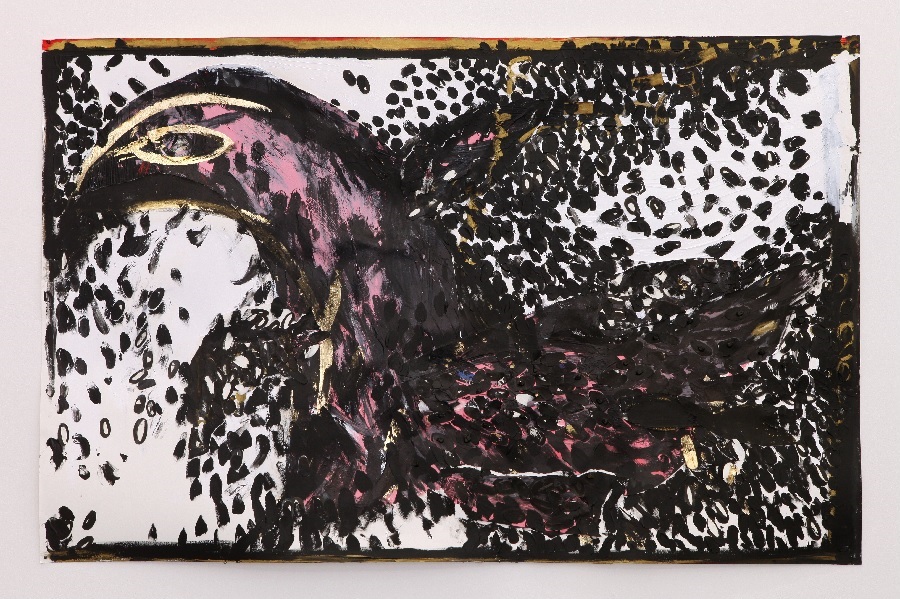Khen Shish
Tunisian Bride
Exhibition opening: Thursday, December 24th, 2015 at 19:30
Gallery talk with the artist: Friday, January 8th, 2016 at 12:00
Exhibition opening: Thursday, December 24th, 2015 at 19:30
Gallery talk with the artist: Friday, January 8th, 2016 at 12:00
Sea of Tears / Tali Tamir
Khen Shish's Tunisian Bride, much like the bride in the well-known play by Nissim Aloni, joins an age-old array of brides who have dressed in their most elegant wedding gowns and as their veil fluttered above them, they fled from the altar to the mythical world of the archetypical bride. This bride, whose groom has never presented himself at her altar (and not the one who ran from her groom in Lorca's "Blood Wedding") – is somewhat of a tricky creature: abandoned and miserable on the one hand, yet at the same time – powerful, independent, and free.
The Tunisian Bride starring in Khen Shish's pink-black-golden painting, representing herself, is washed away by an ocean of tears; up in flames like a martyr, while simultaneously she grows to monumental dimensions, bedecked as befit to a Byzantine queen, she sprouts scorpion's pincers or peacock's wings. Khen rejects gracefulness: her image of the bride has become a ritual hybrid of man/animal, bride/bird of prey, pecking (perhaps) at her groom's liver. The primary pink space of her paintings, saccharine and flowing with hearts, is covered up by a rain of black tears and a flock of sharp-beaked eagles.
The tears receive quite a dramatic empowerment: if in Picasso's "The Weeping Woman" (1937) the tears are enlarged and have a crystal-like presence, in Shish's case, the tears are thick cardboard cutouts glued onto the scenic fabric, gaining a tangible, three-dimensional presence. "An ocean of tears in my two eyes / my heart calls out return to me" – Zohar Argov, the king of Middle Eastern song, sings dramatically to the words of Zmira Chen.
In her previous exhibition, Khen Shish's art spoke of a broken heart calling out for its disappeared lover to return. In the current exhibition, the heart is presented in place of the head, and the tears join in a Bacchanal circle dance. Is the Middle Eastern characteristic of Khen Shish – "The Tunisian" – not looking at the emotional dramatization with the eyes of irony? Maybe even with humor and an implied wink? Perhaps not the tears, but rather the black eyes of the bride/painter, similar to the darkened eyes of the Middle Eastern girls painted by Gutman and Rubin in the twenties – are the key to the charcoal morbidity of these paintings.
During the time spent working on the "Tunisian Bride" series, Khen Shish consciously corresponded with the Moroccan bride appearing in Eugene Delacroix's "Jewish Wedding", painted in 1839. The Moroccan wedding did in fact take place in the city of Tangier, in Morocco, on the February 21st, 1832, and the Parisian painter, charmed by the veiled East revealed to him, documents in his journal in precise detail the shadows, the whiteness of the sleeves, the darkness of the eyes, the beauty of the bride's face, the purple and gold tones of the fabrics, and finally the sunlight lighting falling on the wall. Not a word about the groom. Same is the case in Breughel's Wedding Party, where the groom is left out of the frame. Only in Rembrandt's "Jewish Bride" does the groom appear beside his bride as he gently places his hand on hers… In Kafka's work we find the groom "standing alone, leaning on the door, looking outside", while the bride "stood amidst friends and acquaintances" at the peak of the engagement celebration held "on a nice warm evening in the month of June". Kafka himself, an "insubordinate groom", will always find a way out of marital life, will eventually roll into the body of an insect and will play the role of the inner horror of rejection and incompatibility, compensated by the freedom of creation.
Dizzied by the whirling sensation of creation, Khen Shish's Tunisian Bride stands tall and beautifully black eyed, as she rises up in her own flames into the space of painting and imagination. A flock of ravens flutters around her, and the groom disappears in a cloud of smoke.
ים של דמעות או: הכלה העולה בלהבות
על הציורים החדשים של חן שיש
"גץ: שמלת כלה... האופנה של נשים זה בזבוז!
מי: זה בזבוז כשאישה לובשת שמלת חתונה?
גץ: לא, לא, לא... כשיש חתונה...
מי: אבל צריכה להיות חתונה ...
גץ: חתונה שלך?
מי: אתה לא חושב שאני אלבש שמלת כלה לחתונה לא שלי, לא?
גץ: על זה לא חשבתי
מי: תפרתי שמלה באופן מיוחד. בפעם אחת. דק –
גץ: ואיפה החתן שלך, מי?
מי: לא בא..."
ניסים אלוני, "הכלה וצייד הפרפרים"
הכלה הטוניסאית של חן שיש, בדומה לכלה במחזה הנודע של ניסים אלוני, מצטרפת למסדר עתיק של כלות שלבשו את שמלות החופה ההדורות שלהן וכשההינומה מתנפנפת מעל לראשן - ברחו מחופתן אל העולם המיתי של הכלה הארכיטיפית. הכלה הזו, שחתנה מעולם לא התייצב לחופתה (ולא זו שברחה מחתנה כמו ב"חתונת הדמים" של לורקה) - היא יצור מתעתע: נטושה ואומללה מצד אחד, אך בו בזמן – מלאת כוח, עצמאות וחופש פנימי. הכלה הטוניסאית שמככבת בציורים הוורודים-שחורים-מוזהבים של חן שיש, ומייצגת אותה–עצמה, נשטפת בים של דמעות, עולה בלהבות כקדושה מעונה, אך בו בזמן צומחת לממדים מונומנטליים, מקושטת כמלכה ביזנטית ומצמיחה צבתות של עקרב או כנפיים של טווס. חן מסרבת לחינניות: דמות הכלה הפכה אצלה להיבריד פולחני של אדם/חיה, כלה/ציפור טרף, שמנקרת (אולי) את כבדו של חתנה. המרחב הוורוד הראשוני בציוריה, מתקתק ושופע לבבות, מתכסה עד חנק במטר של דמעות שחורות ובלהק של נשרים חדי מקור. הדמעות מקבלות כאן העצמה דרמטית: אם בציור של פיקאסו "האישה הבוכה" (1937) הדמעות מוגדלות ומקבלות נוכחות קריסטלית של טיפות, הרי אצל שיש הדמעות גזורות מקרטון עבה ומודבקות אל תוך המארג הציורי, צוברות נוכחות מוחשית ותלת ממדית. "ים של דמעות בשתי עיני / ליבי זועק שובה אלי" – שר בדרמטיות זוהר ארגוב, מלך הזמר המזרחי, את מילותיה של זמירה חן. ואכן, בתערוכתה הקודמת עסקה חן שיש בלב שבור הזועק לאהוב הנעלם שישוב. בתערוכה הנוכחית, הלב מתייצב במקום של הראש והדמעות מסתחררות לריקוד מעגלי-בכחנאלי. האם המזרחיות המוצהרת של חן שיש – "הטוניסאית" – אינה מתבוננת בדרמטיזציה הרגשית המועצמת בעין אירונית? אולי אפילו בהומור ובקריצה סמויה? ייתכן ולא הדמעות, אלא דווקא עיניה השחורות של הכלה/הציירת, המזכירות את עיני הפחם של נערות המזרח של גוטמן וראובן בציורי שנות העשרים – הן המפתח לפחמיות המורבידית של הציורים הללו.
במהלך העבודה על הסדרה "כלה טוניסאית" התכתבה חן שיש במודע עם הכלה המרוקאית בציורו של אויז'ן דלקרואה "חתונה יהודית", שצוייר ב-1839. החתונה המרוקאית אכן התקיימה בעיר טאנג'יר, שבמרוקו, ב-21 בפברואר 1832, והצייר הפריזאי, המוקסם מהמזרח המצועף הנגלה לעיניו, מפרט ביומנו בדייקנות את ריבוי הצללים, לובן השרוולים, כהות העיניים, יפי פניה של הכלה, גווני הסגול והזהב של האריגים ואור השמש המאיר את הקיר. אף מילה על החתן. גם בסעודת החתונה של ברויגל החתן נותר מחוץ לפריים ורק ב"כלה היהודייה" של רמברנדט ניצב החתן ליד כלתו ומניח עליה בעדינות את ידו... אצל קפקא אנחנו מוצאים את החתן "עומד לבדו, שעון אל הדלת ומביט החוצה", בזמן שהכלה "עמדה בתוך מעגל של חברות ומכרים" בשיאה של חגיגת האירוסין שנערכה "בערב חמים ויפה בחודש יוני". גם קפקא, החתן הסרבן, שתמיד ימצא דרך לחמוק מחיי הנישואין, יתגלגל, בסופו של דבר לתוך גוף של חרק, ויגלם את האימה הפנימית של הסירוב ואי ההלימה, שהפיצוי עליה הוא חירות היצירה.
מסוחררת מחדוות יצירה, ניצבת הכלה הטוניסאית של חן שיש, שחורת עיניים ויפת מבט, עולה בלהבות הלהט שלה-עצמה אל מרחב הציור והדמיון. להקת עורבים מתעופפת מסביבה, והחתן נעלם בענני העשן.
טלי תמיר




